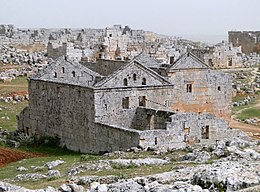| UNESCO World Heritage Site | |
|---|---|
 View of Serjilla | |
| Location | Limestone Massif, Syria |
| Includes | |
| Criteria | Cultural: (iii)(iv)(v) |
| Reference | 1348 |
| Inscription | 2011 (35th Session) |
| Endangered | 2013–present |
| Area | 12,290 ha (30,400 acres) |
| Coordinates | 36°20′3″N 36°50′39″E / 36.33417°N 36.84417°E |
The Dead Cities (Arabic: المدن الميتة) or Forgotten Cities (Arabic: المدن المنسية) are a group of 700 abandoned settlements in northwest Syria between Aleppo and Idlib. Around 40 villages grouped in eight archaeological parks situated in north-western Syria provide an insight into rural life in Late Antiquity and during the Byzantine period. Most of the villages, which date from the 1st to 7th centuries, were abandoned between the 8th and 10th centuries. The settlements feature the well-preserved architectural remains of dwellings, pagan temples, churches, cisterns, bathhouses, etc. Important dead cities include the Church of Saint Simeon Stylites, Dahis, Serjilla, Ruweiha and al Bara.
The Dead Cities are situated in an elevated area of limestone known as Limestone Massif. These ancient settlements cover an area 20–40 km (12–25 mi) wide and some 140 km (87 mi) long.[1] The Massif includes three groups of highlands: the first is the northern group of Mount Simeon and Mount Kurd; the second middle group is the group of Harim Mountains; the third southern group is the group of Zawiya Mountain.
- ^ Burns, Ross., Monuments of Syria: An Historical Guide, p. 109

